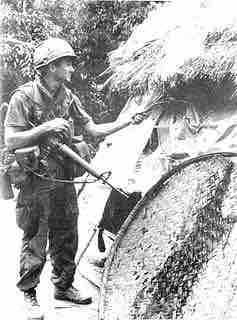Agenda-Setting in Foreign Policy
One way in which the media could set the agenda is if it is in an area in which very few Americans have direct knowledge of the issues. This applies to foreign policy. When American military personnel are involved, the media needs to report because the personnel are related to the American public. The media is also likely to have an interest in reporting issues that have substantial effects on American workers, such as major trade agreements with Mexico during the NAFTA negotiations in the 1990's.
David McKay, author of American Politics and Society, lists as one of the three main distortions of information by the media, "Placing high priority on American news to the detriment of foreign news. And when the U.S. is engaged in military action abroad, this 'foreign news' crowds out other foreign news. "
News Media and the Vietnam War
In the media's most famous case in involvement on foreign affairs was its involvement in the Vietnam War. From 40 press corpsmen in 1964, the number in South Vietnam had grown to 282 by January 1966. By August that number had jumped to 419. Of the 282 at the beginning of the year, only 110 were Americans. 67 were South Vietnamese, 26 Japanese, 24 British, 13 Korean, 11 French, and seven German. The media caught many combat events, usually on live television, which prompted many American citizens to be concerned about foreign policy .

Soldier in Vietnam
Graphics like this helped contribute to Americans' concern over foreign policy in Vietnam.
The U.S. Mission and the MACV (Military Assistance Command) also installed an "information czar," the U.S. Mission's Minister-Counselor for Public Affairs, Barry Zorthian, advised General William Westmoreland on public affairs matters. He had theoretical responsibility under the ambassador for the development of all information policy. He maintained liaison between the embassy, MACV, and the press; publicized information to refute erroneous and misleading news stories; and sought to assist the Saigon correspondents in covering the side of the war most favorable to the policies of the U.S. government. Zorthian possessed both experience with the media and a great deal of patience and tact while maintaining reasonably good relations with the press corps. Media correspondents were invited to attend nightly MACV briefings covering the day's events that became known as the "Five O'Clock Follies. " Most correspondents considered these briefings to be a waste of time. The Saigon bureau chiefs were also often invited to closed sessions at which presentations would be made by a briefing officer, the CIA station chief, or an official from the embassy who would present background or off-the-record information on upcoming military operations or Vietnamese political events.
According to Daniel Hallin, the dramatic structure of the uncensored "living room war" as reported during 1965–1967 remained simple and traditional: "the forces of good were locked in battle once again with the forces of evil. What began to change in 1967 was the conviction that the forces of good would inevitably prevail. " During late 1967 the MACV had also begun to disregard the decision it had made at the Honolulu Conference that the military should leave the justification of the war to elected officials in Washington. The military found itself drawn progressively into politics, to the point that it had become as involved in "selling" the war to the American public as the political appointees it served. This change would have far-reaching detrimental effects.
Media Bias
A self-described liberal media watchdog group, Fairness and Accuracy in Reporting (FAIR), in consultation with the Survey and Evaluation Research Laboratory at Virginia Commonwealth University, sponsored an academic study in which journalists were asked a range of questions about how they did their work and about how they viewed the quality of media coverage in the broad area of politics and economic policy. "They were asked for their opinions and views about a range of recent policy issues and debates. Finally, they were asked for demographic and identifying information, including their political orientation." They then compared to the same or similar questions posed with "the public" based on Gallup, and Pew Trust polls. Their study concluded that a majority of journalists, although relatively liberal on social policies, were significantly to the right of the public on economic, labor, health care, and foreign policy issues.